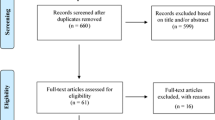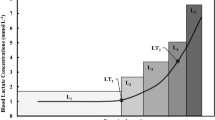Summary
The heart rate/work performance (f c/W) curve is usually S-shaped but a flattening at the top is not always seen. By means of radionuclide ventricular scintigraphy, the left ventricular ejection fraction (LVEF) of 15 sports students was investigated. The behaviour of the f c/W curve during cycle ergometry with increasing exercise intensities was examined. During exercise, the LVEF showed a distinct initial increase reaching roughly constant values at stress levels below-maximum, and sometimes even falling again. The inflections of the f c/W curve and left ventricular ejection fraction/performance curve (LVEFPC) were calculated from a second degree polynomial fit. From this function, the slopes of the tangents at the points of aerobic threshold and maximum performance were calculated together with the differences of the angles as a measure of the f c/W curve and LVEFPC inflections. It follows that the f c/W curve inflection became less pronounced or was even absent altogether when the decrease in LVEF towards the end of the ergometer exercise became more distinct. A significant negative correlation was found between the existence and extent of the f c/W curve inflection and the stress-dependent myocardial function, expressed as the inflection of the LVEFPC (P<0.01, r=0.673). Thus, it would seem that the absence of a f c/W curve inflection was related to a diminished stress-dependent myocardial function.
Similar content being viewed by others
References
Boehringer Mannheim (1987) Test-combination lactate fully enzymatic. Boehringer Mannheim, Mannheim
Bunc V, Heller J (1992) Comparison of two methods of noninvasive anaerobic threshold determination in middle-aged men. Sports Med Training Rehabil 3:87–94
Bunc V, Heller J, Leso J (1988) Kinetics of heart rate responses to exercise. J Sports Sci 6:39–48
Bunc V, Hofmann P, Gaisl G (1989) A comparison of the two nonivasive methods of the determination of the anaerobic threshold. Med Sport Sci 29:75–77
Cerqueira MD, Harp GD, Ritchie JL, Stratton JR, Walker RD (1991) Rarity of preclinical alcoholic cardiomyopathy in chronic alcoholics <40 years of age. Am J Cardiol 67:183–187
Choi BW, Wassermann AG, Katz RJ, Varma V, Reba RC, Ross AM (1989) Clinical and hemodynamic significance of left ventricular diastolic volume changes by exercise radionuclide ventriculography in coronary artery disease. Am J Cardiol 63:522–525
Conconi F, Ferrari M, Ziglo PG, Droghrtti P, Codeca L (1982) Determination of the anaerobic threshold by a noninvasive field test in runners. J Appl Physiol 52:869–873
Gaisl G, Wiesspeiner G (1987) A noninvasive method of determining the anaerobic threshold in children. Int J Sports Med 8:41–44
Gaisl G, Hofmann P, Bunc V (1991) Standardisation of a noninvasive method of determining the anaerobic threshold in children. In: Frenkl R, Szmodis I (eds) Children and exercise. Pediatric work physiology XV. National Institute for Health Promotion (NEVI), Budapest, Hungary, pp 234–241
Heck H, Beckers K, Lammerschmidt W, Purin E, Hess G, Hollmann W (1989) Identification, objectivity and validity of Conconi threshold by cycle stress tests. Dtsch Z Sportmed 40:388–412
Israel S (1982) Sport and Herzschlagfrequenz. Barth, Leipzig
Keul J, Dickhuth HH, Lehmann M, Staiger J (1982) The athlete's heart — haemodynamics and structure. Int J Sportsmed 3:33–43
Pendergast D, Ceretelli P, Rennie DW (1979) Aerobic and glycolytic metabolism in arm exercise. J Appl Physiol 47:754–760
Ribeiro JP, Fielding RA, Hughes V, Black A, Bochese MA, Knuttgen HG (1985) Heart rate break point may coincide with the anaerobic and not the aerobic threshold. Int J Sports Med 6:220–224
Rubal BJ, Moody JM, Damore S, Bunker SR, Diaz NM (1986) Left ventricular performance of the athletic heart during upright exercise. A heart rate-controlled study. Med Sci Sports Exerc 18:134–140
Standke R, Hör G, Maul FD (1983) Fully automated secretorial equilibrium radionuclide ventriculography. Eur J Nucl Med 8:77–83
Tiedt N, Wohlgemuth B (1973) Die statistische Kennlinie der Belastungsherzfrequenz. Med Sport 13:87–94
Younis LT, Melin JA, Robert AR, Detry JM (1990) Influence of age and sex on left ventricular volumes and ejection fraction during upright exercise in normal subjects. Eur Heart J 11:916–924
Author information
Authors and Affiliations
Rights and permissions
About this article
Cite this article
Pokan, R., Hofmann, P., Preidler, K. et al. Correlation between inflection of heart rate/work performance curve and myocardial function in exhausting cycle ergometer exercise. Europ. J. Appl. Physiol. 67, 385–388 (1993). https://doi.org/10.1007/BF00376453
Accepted:
Issue Date:
DOI: https://doi.org/10.1007/BF00376453




